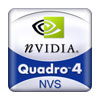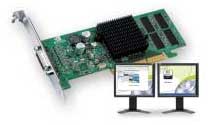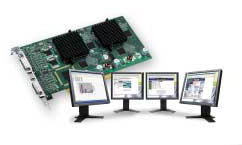NVIDIA's Quadro4 Preview: Threatening the Competition
by Anand Lal Shimpi on February 19, 2002 12:00 PM EST- Posted in
- GPUs
Quadro4 NVS: Targeting Matrox
 At
the very start of this preview we mentioned that the second largest share of
the x86 workstation graphics market belongs to none other than Matrox. Matrox
has been able to acquire a strong foothold in this market and stay there for
so long because of the fact that there is still a large percentage of the workstation
market that does not depend on lightning fast 3D acceleration. This market segment
is more interested in 2D image quality, multi-monitor support, and other such
features that have nothing to do with how many pixel or vertex shader pipelines
you have.
At
the very start of this preview we mentioned that the second largest share of
the x86 workstation graphics market belongs to none other than Matrox. Matrox
has been able to acquire a strong foothold in this market and stay there for
so long because of the fact that there is still a large percentage of the workstation
market that does not depend on lightning fast 3D acceleration. This market segment
is more interested in 2D image quality, multi-monitor support, and other such
features that have nothing to do with how many pixel or vertex shader pipelines
you have.
Take the financial market for example; at the top financial analyst firms it is commonplace to have more than two monitors at a desktop workstation, and until recently neither ATI nor NVIDIA's multimonitor solutions would support more than 2 CRT/LCD displays. The introduction of NVIDIA's nView changes that as the name implies that it supports up to n-displays.
The Quadro4 NVS line is targeted squarely at Matrox's market share and it does so with two distinct products - the 200 NVS and the 400 NVS. Although the Quadro4 NVS GPU is based off of the NV17GL chip, the cards are not certified for use in any 3D applications. NVIDIA's reasoning behind this is that these markets aren't concerned with 3D performance and the NVS line will have particularly poor 3D performance (much like the Matrox cards they're up against). This leads us to believe that the core/memory clocks of the NVS lines will be noticeably lower than that of the GeForce4 MX desktop lines, potentially even lower than the GeForce4 MX 420.

The Quadro4 200 NVS is an AGP solution with a 128-bit SDR SDRAM bus much like the GeForce4 MX 420. This part features a single 60-pin output connector known as a Low Force Helix (LFH). Dongles will be made available that can split this single connector into dual DVI or dual VGA ports. The LFH connector will also be found on the Quadro4 500/550 XGL as well as the Quadro4 400 NVS.
The 400 NVS is aimed directly at a niche market controlled almost entirely by Matrox at this point - the > 2-monitor display market. Matrox currently ships a version of their old G200 known as the G200 Multi-Monitor Series (MMS) with support for up to 4 displays. As you can probably guess, a single 400 NVS card can support up to 4 displays as well through the use of two LFH connectors for maximum flexibility in terms of VGA/DVI combinations.

NVIDIA enabled support for 4 displays by placing two NV17GL chips on the 400 NVS' PCB. Although all NVIDIA chips since the NV20 have an integrated AGP bridge NVIDIA has still not worked out all the kinks with bringing a multi-chip AGP solution to market and thus the 400 NVS remains a PCI card. Without any need for 3D performance the PCI bus does just fine for normal graphics and it provides an interesting expansion capability across the bus; users are able to use multiple 400 NVS cards to support up to 32 displays.
The 400 NVS is outfitted with a 64-bit DDR memory bus and is again, not certified for any professional 3D applications. That doesn't mean it won't work under them, it just means that the performance is low enough that NVIDIA would rather you not use it as a 3D card.
The final point to make about the NVS line is that although the cards are all derived off of a platform similar to the GeForce4 MX, nView has been improved a bit allowing for more desktops and hotkeys.










0 Comments
View All Comments